Dissertation: Environmental Change, Staff Impact at Tevamit Properties
VerifiedAdded on 2023/04/04
|47
|11239
|337
Thesis and Dissertation
AI Summary
This dissertation investigates the impact of workspace environmental changes on staff psychology and productivity within Tevamit Properties. It examines the evolving nature of work, from the industrial age to the knowledge economy, and how these changes necessitate adaptable workspaces. The study addresses the problem of whether providing employees with the freedom to choose their work environment—such as co-working spaces, cafes, homes, or vacation locations—affects their psychological well-being and productivity. The research outlines its aims, objectives, and structure, including a literature review covering the concept and benefits of co-working spaces, a methodology section detailing the research philosophy, approach, design, data collection, and analysis methods, and finally, an ethical consideration. The study further analyzes quantitative data to derive conclusions and recommendations based on the findings.
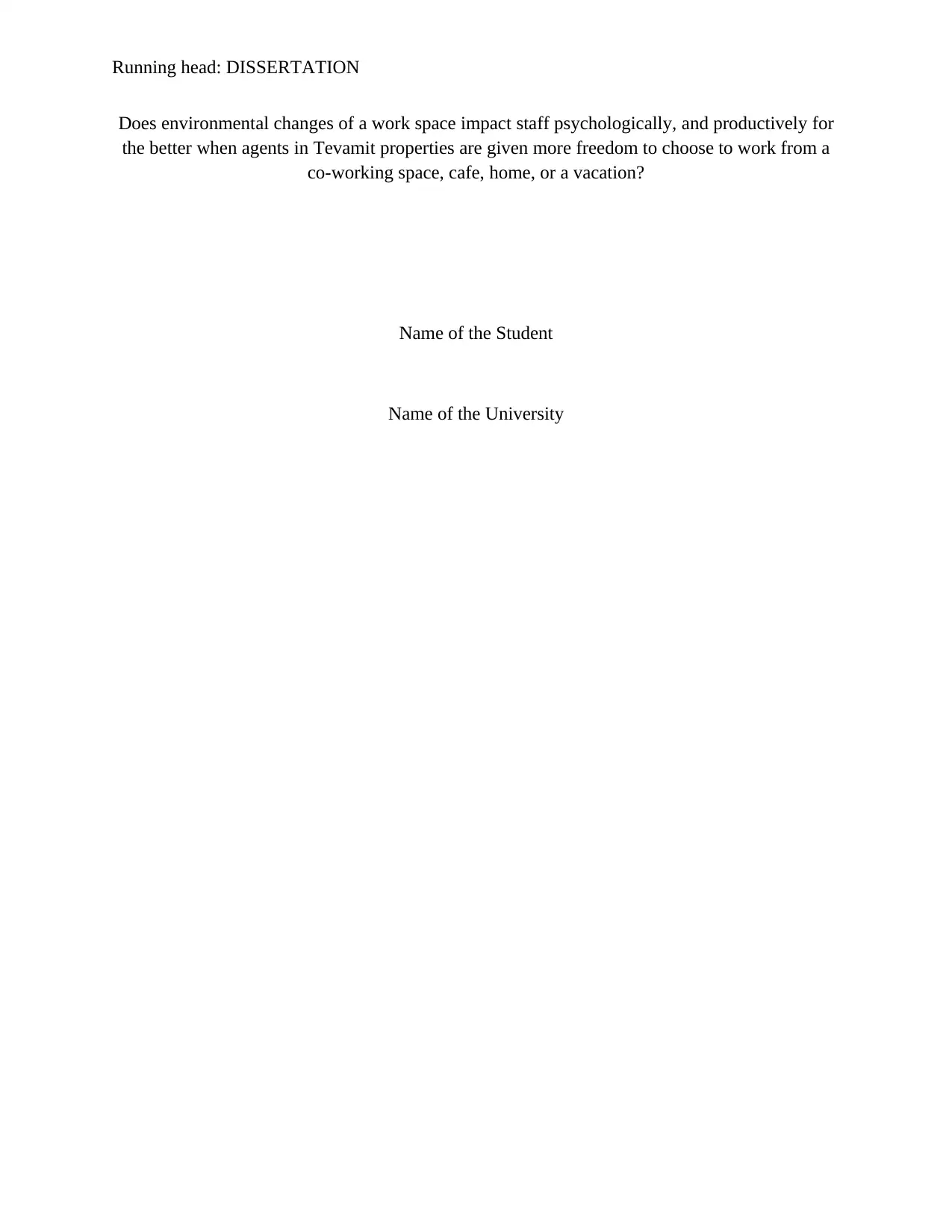
Running head: DISSERTATION
Does environmental changes of a work space impact staff psychologically, and productively for
the better when agents in Tevamit properties are given more freedom to choose to work from a
co-working space, cafe, home, or a vacation?
Name of the Student
Name of the University
Does environmental changes of a work space impact staff psychologically, and productively for
the better when agents in Tevamit properties are given more freedom to choose to work from a
co-working space, cafe, home, or a vacation?
Name of the Student
Name of the University
Paraphrase This Document
Need a fresh take? Get an instant paraphrase of this document with our AI Paraphraser
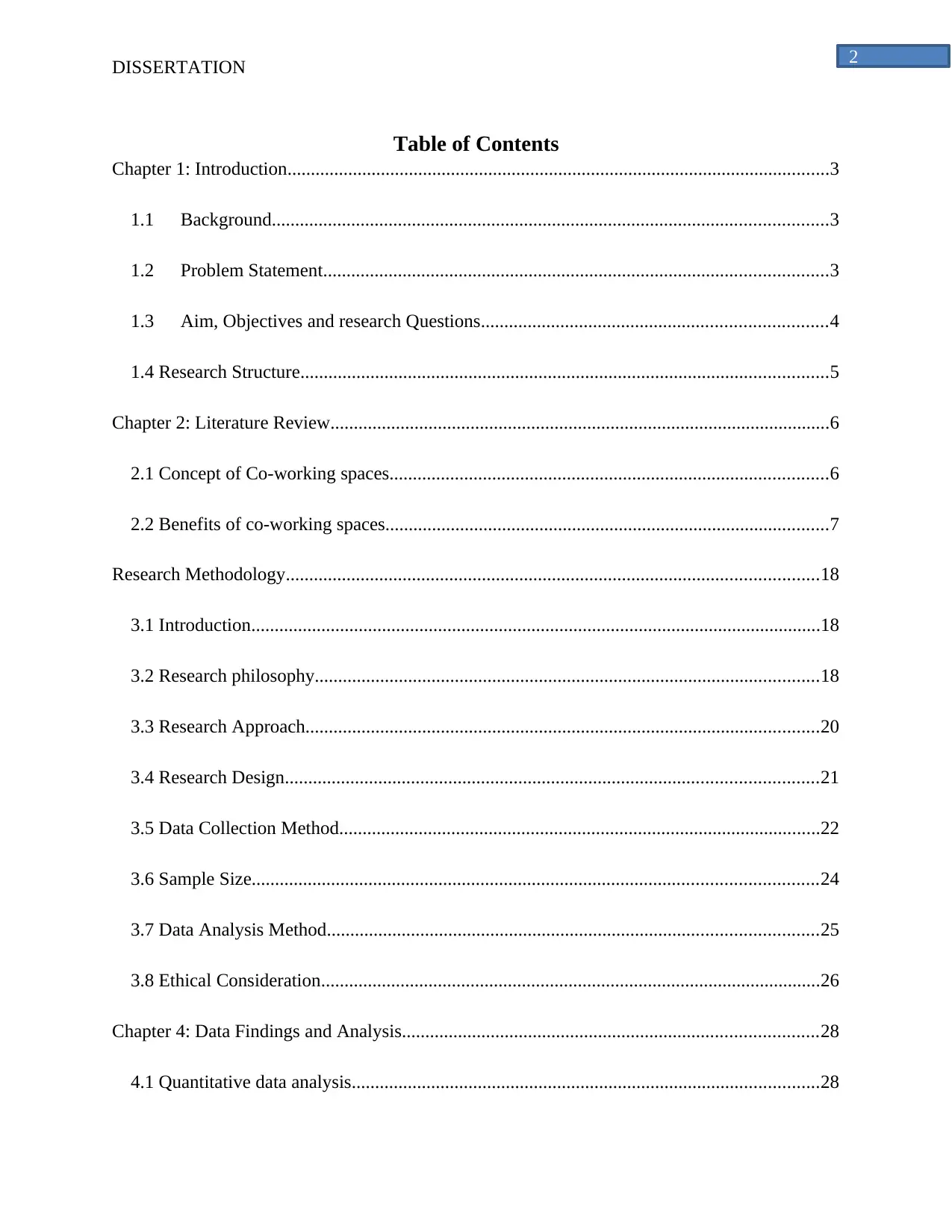
2
DISSERTATION
Table of Contents
Chapter 1: Introduction....................................................................................................................3
1.1 Background.......................................................................................................................3
1.2 Problem Statement............................................................................................................3
1.3 Aim, Objectives and research Questions..........................................................................4
1.4 Research Structure.................................................................................................................5
Chapter 2: Literature Review...........................................................................................................6
2.1 Concept of Co-working spaces..............................................................................................6
2.2 Benefits of co-working spaces...............................................................................................7
Research Methodology..................................................................................................................18
3.1 Introduction..........................................................................................................................18
3.2 Research philosophy............................................................................................................18
3.3 Research Approach..............................................................................................................20
3.4 Research Design..................................................................................................................21
3.5 Data Collection Method.......................................................................................................22
3.6 Sample Size.........................................................................................................................24
3.7 Data Analysis Method.........................................................................................................25
3.8 Ethical Consideration...........................................................................................................26
Chapter 4: Data Findings and Analysis.........................................................................................28
4.1 Quantitative data analysis....................................................................................................28
DISSERTATION
Table of Contents
Chapter 1: Introduction....................................................................................................................3
1.1 Background.......................................................................................................................3
1.2 Problem Statement............................................................................................................3
1.3 Aim, Objectives and research Questions..........................................................................4
1.4 Research Structure.................................................................................................................5
Chapter 2: Literature Review...........................................................................................................6
2.1 Concept of Co-working spaces..............................................................................................6
2.2 Benefits of co-working spaces...............................................................................................7
Research Methodology..................................................................................................................18
3.1 Introduction..........................................................................................................................18
3.2 Research philosophy............................................................................................................18
3.3 Research Approach..............................................................................................................20
3.4 Research Design..................................................................................................................21
3.5 Data Collection Method.......................................................................................................22
3.6 Sample Size.........................................................................................................................24
3.7 Data Analysis Method.........................................................................................................25
3.8 Ethical Consideration...........................................................................................................26
Chapter 4: Data Findings and Analysis.........................................................................................28
4.1 Quantitative data analysis....................................................................................................28

3
DISSERTATION
Chapter 5: Conclusion and Recommendations..............................................................................39
References......................................................................................................................................42
DISSERTATION
Chapter 5: Conclusion and Recommendations..............................................................................39
References......................................................................................................................................42
⊘ This is a preview!⊘
Do you want full access?
Subscribe today to unlock all pages.

Trusted by 1+ million students worldwide
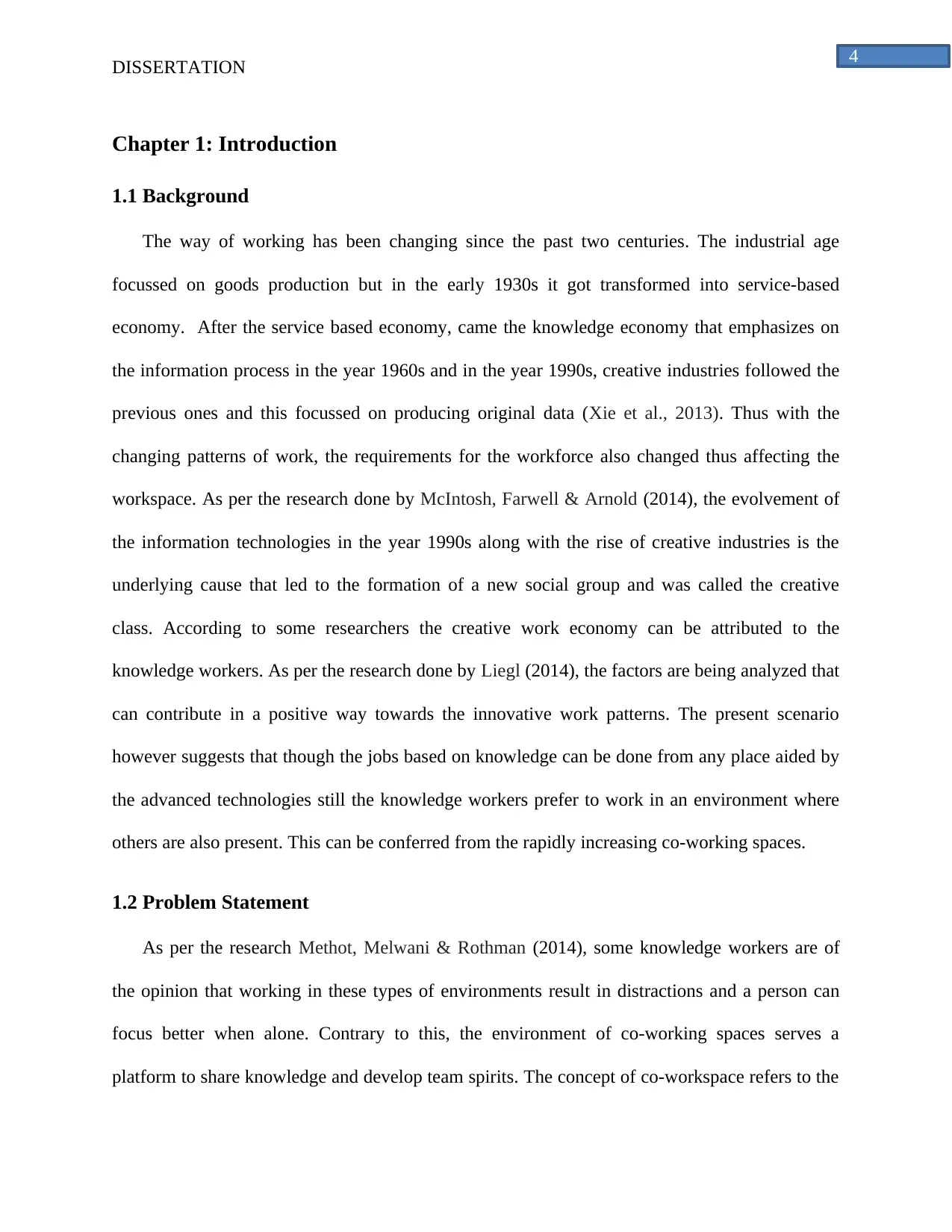
4
DISSERTATION
Chapter 1: Introduction
1.1 Background
The way of working has been changing since the past two centuries. The industrial age
focussed on goods production but in the early 1930s it got transformed into service-based
economy. After the service based economy, came the knowledge economy that emphasizes on
the information process in the year 1960s and in the year 1990s, creative industries followed the
previous ones and this focussed on producing original data (Xie et al., 2013). Thus with the
changing patterns of work, the requirements for the workforce also changed thus affecting the
workspace. As per the research done by McIntosh, Farwell & Arnold (2014), the evolvement of
the information technologies in the year 1990s along with the rise of creative industries is the
underlying cause that led to the formation of a new social group and was called the creative
class. According to some researchers the creative work economy can be attributed to the
knowledge workers. As per the research done by Liegl (2014), the factors are being analyzed that
can contribute in a positive way towards the innovative work patterns. The present scenario
however suggests that though the jobs based on knowledge can be done from any place aided by
the advanced technologies still the knowledge workers prefer to work in an environment where
others are also present. This can be conferred from the rapidly increasing co-working spaces.
1.2 Problem Statement
As per the research Methot, Melwani & Rothman (2014), some knowledge workers are of
the opinion that working in these types of environments result in distractions and a person can
focus better when alone. Contrary to this, the environment of co-working spaces serves a
platform to share knowledge and develop team spirits. The concept of co-workspace refers to the
DISSERTATION
Chapter 1: Introduction
1.1 Background
The way of working has been changing since the past two centuries. The industrial age
focussed on goods production but in the early 1930s it got transformed into service-based
economy. After the service based economy, came the knowledge economy that emphasizes on
the information process in the year 1960s and in the year 1990s, creative industries followed the
previous ones and this focussed on producing original data (Xie et al., 2013). Thus with the
changing patterns of work, the requirements for the workforce also changed thus affecting the
workspace. As per the research done by McIntosh, Farwell & Arnold (2014), the evolvement of
the information technologies in the year 1990s along with the rise of creative industries is the
underlying cause that led to the formation of a new social group and was called the creative
class. According to some researchers the creative work economy can be attributed to the
knowledge workers. As per the research done by Liegl (2014), the factors are being analyzed that
can contribute in a positive way towards the innovative work patterns. The present scenario
however suggests that though the jobs based on knowledge can be done from any place aided by
the advanced technologies still the knowledge workers prefer to work in an environment where
others are also present. This can be conferred from the rapidly increasing co-working spaces.
1.2 Problem Statement
As per the research Methot, Melwani & Rothman (2014), some knowledge workers are of
the opinion that working in these types of environments result in distractions and a person can
focus better when alone. Contrary to this, the environment of co-working spaces serves a
platform to share knowledge and develop team spirits. The concept of co-workspace refers to the
Paraphrase This Document
Need a fresh take? Get an instant paraphrase of this document with our AI Paraphraser
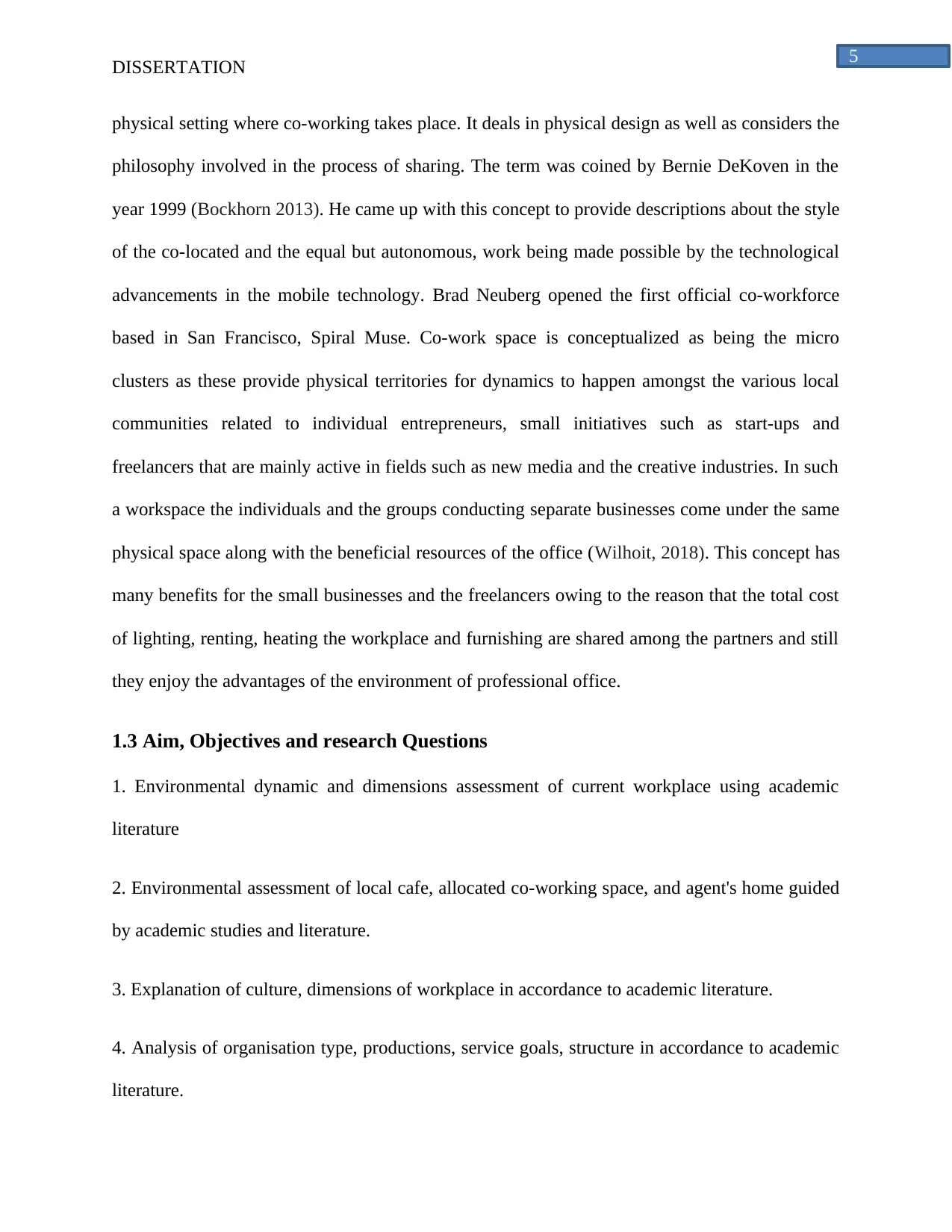
5
DISSERTATION
physical setting where co-working takes place. It deals in physical design as well as considers the
philosophy involved in the process of sharing. The term was coined by Bernie DeKoven in the
year 1999 (Bockhorn 2013). He came up with this concept to provide descriptions about the style
of the co-located and the equal but autonomous, work being made possible by the technological
advancements in the mobile technology. Brad Neuberg opened the first official co-workforce
based in San Francisco, Spiral Muse. Co-work space is conceptualized as being the micro
clusters as these provide physical territories for dynamics to happen amongst the various local
communities related to individual entrepreneurs, small initiatives such as start-ups and
freelancers that are mainly active in fields such as new media and the creative industries. In such
a workspace the individuals and the groups conducting separate businesses come under the same
physical space along with the beneficial resources of the office (Wilhoit, 2018). This concept has
many benefits for the small businesses and the freelancers owing to the reason that the total cost
of lighting, renting, heating the workplace and furnishing are shared among the partners and still
they enjoy the advantages of the environment of professional office.
1.3 Aim, Objectives and research Questions
1. Environmental dynamic and dimensions assessment of current workplace using academic
literature
2. Environmental assessment of local cafe, allocated co-working space, and agent's home guided
by academic studies and literature.
3. Explanation of culture, dimensions of workplace in accordance to academic literature.
4. Analysis of organisation type, productions, service goals, structure in accordance to academic
literature.
DISSERTATION
physical setting where co-working takes place. It deals in physical design as well as considers the
philosophy involved in the process of sharing. The term was coined by Bernie DeKoven in the
year 1999 (Bockhorn 2013). He came up with this concept to provide descriptions about the style
of the co-located and the equal but autonomous, work being made possible by the technological
advancements in the mobile technology. Brad Neuberg opened the first official co-workforce
based in San Francisco, Spiral Muse. Co-work space is conceptualized as being the micro
clusters as these provide physical territories for dynamics to happen amongst the various local
communities related to individual entrepreneurs, small initiatives such as start-ups and
freelancers that are mainly active in fields such as new media and the creative industries. In such
a workspace the individuals and the groups conducting separate businesses come under the same
physical space along with the beneficial resources of the office (Wilhoit, 2018). This concept has
many benefits for the small businesses and the freelancers owing to the reason that the total cost
of lighting, renting, heating the workplace and furnishing are shared among the partners and still
they enjoy the advantages of the environment of professional office.
1.3 Aim, Objectives and research Questions
1. Environmental dynamic and dimensions assessment of current workplace using academic
literature
2. Environmental assessment of local cafe, allocated co-working space, and agent's home guided
by academic studies and literature.
3. Explanation of culture, dimensions of workplace in accordance to academic literature.
4. Analysis of organisation type, productions, service goals, structure in accordance to academic
literature.
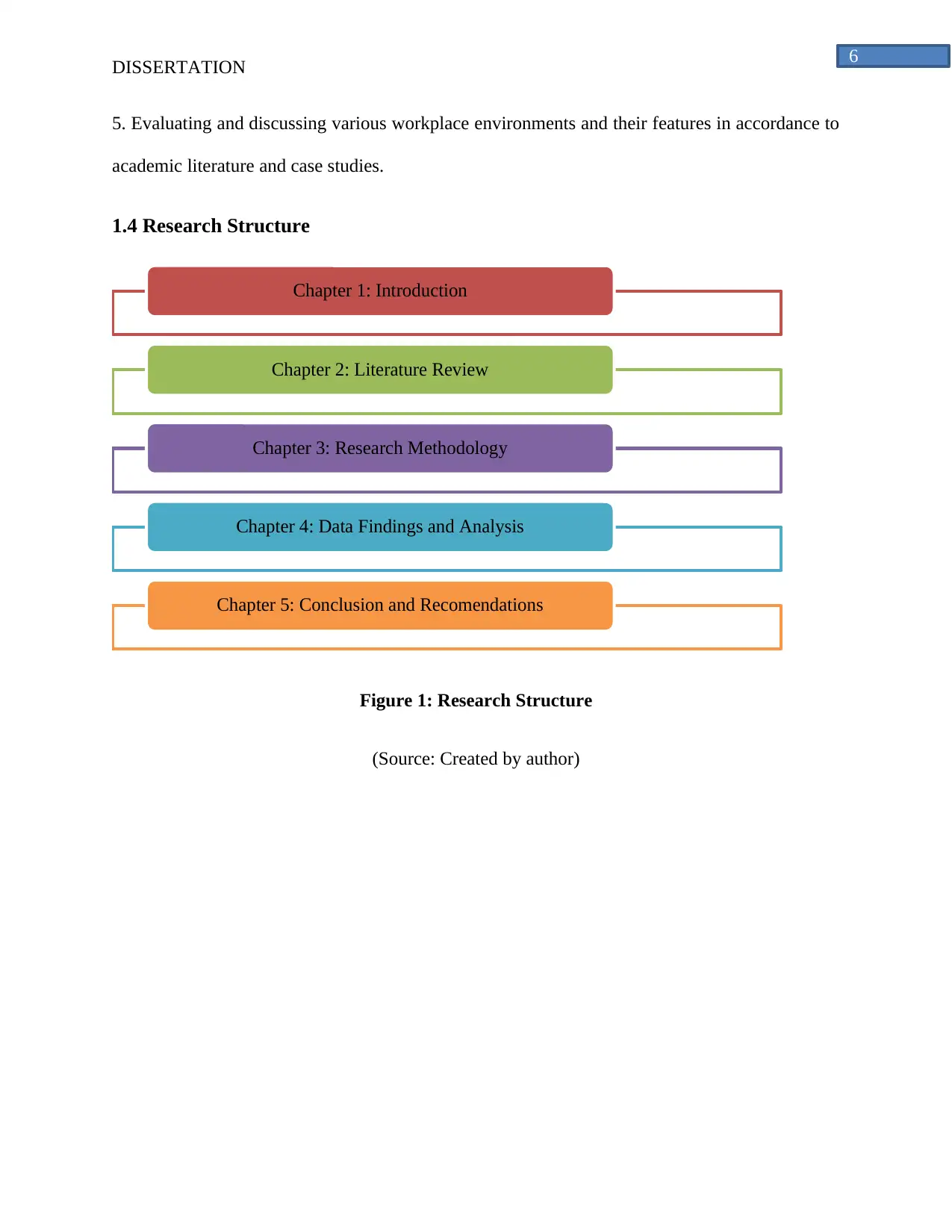
6
DISSERTATION
5. Evaluating and discussing various workplace environments and their features in accordance to
academic literature and case studies.
1.4 Research Structure
Figure 1: Research Structure
(Source: Created by author)
Chapter 1: Introduction
Chapter 2: Literature Review
Chapter 3: Research Methodology
Chapter 4: Data Findings and Analysis
Chapter 5: Conclusion and Recomendations
DISSERTATION
5. Evaluating and discussing various workplace environments and their features in accordance to
academic literature and case studies.
1.4 Research Structure
Figure 1: Research Structure
(Source: Created by author)
Chapter 1: Introduction
Chapter 2: Literature Review
Chapter 3: Research Methodology
Chapter 4: Data Findings and Analysis
Chapter 5: Conclusion and Recomendations
⊘ This is a preview!⊘
Do you want full access?
Subscribe today to unlock all pages.

Trusted by 1+ million students worldwide
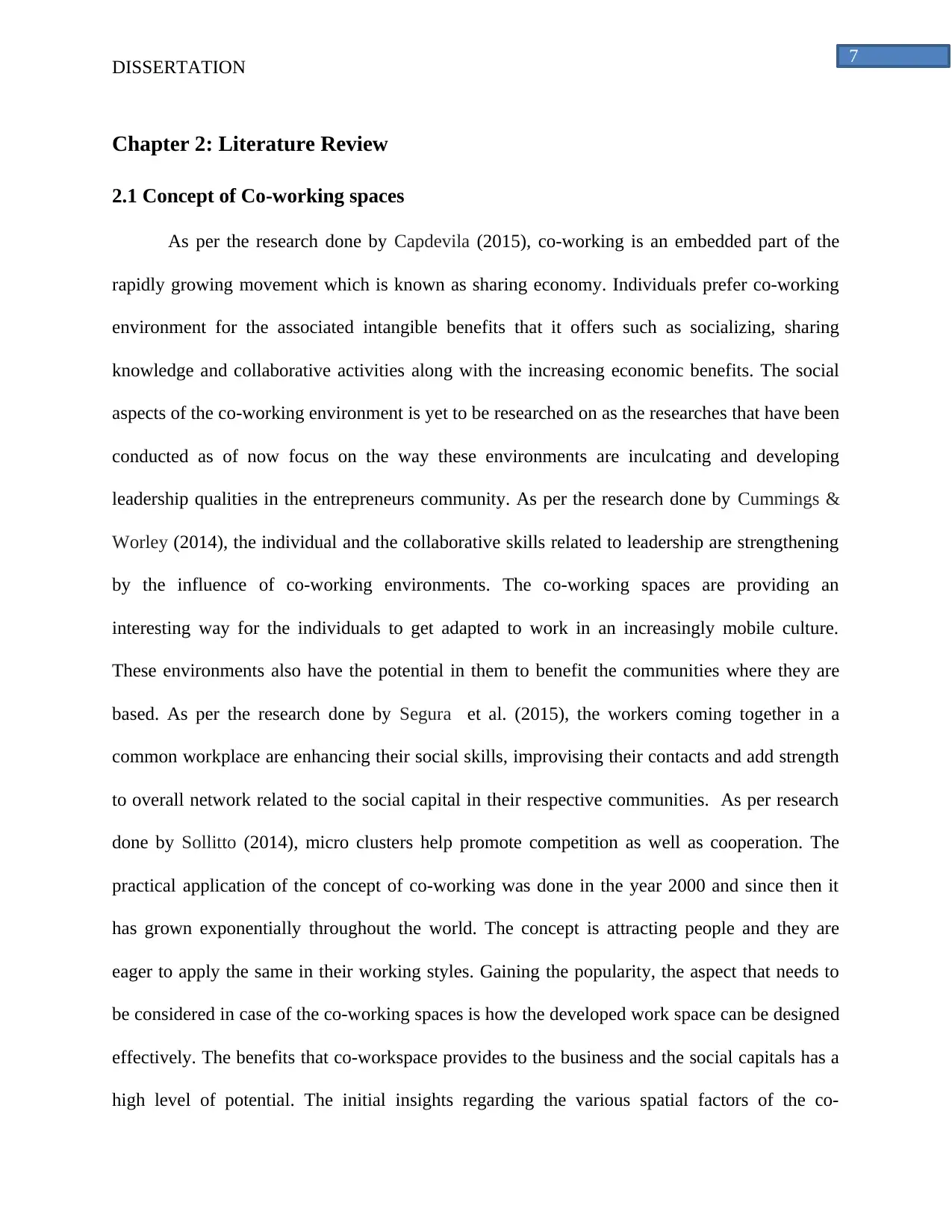
7
DISSERTATION
Chapter 2: Literature Review
2.1 Concept of Co-working spaces
As per the research done by Capdevila (2015), co-working is an embedded part of the
rapidly growing movement which is known as sharing economy. Individuals prefer co-working
environment for the associated intangible benefits that it offers such as socializing, sharing
knowledge and collaborative activities along with the increasing economic benefits. The social
aspects of the co-working environment is yet to be researched on as the researches that have been
conducted as of now focus on the way these environments are inculcating and developing
leadership qualities in the entrepreneurs community. As per the research done by Cummings &
Worley (2014), the individual and the collaborative skills related to leadership are strengthening
by the influence of co-working environments. The co-working spaces are providing an
interesting way for the individuals to get adapted to work in an increasingly mobile culture.
These environments also have the potential in them to benefit the communities where they are
based. As per the research done by Segura et al. (2015), the workers coming together in a
common workplace are enhancing their social skills, improvising their contacts and add strength
to overall network related to the social capital in their respective communities. As per research
done by Sollitto (2014), micro clusters help promote competition as well as cooperation. The
practical application of the concept of co-working was done in the year 2000 and since then it
has grown exponentially throughout the world. The concept is attracting people and they are
eager to apply the same in their working styles. Gaining the popularity, the aspect that needs to
be considered in case of the co-working spaces is how the developed work space can be designed
effectively. The benefits that co-workspace provides to the business and the social capitals has a
high level of potential. The initial insights regarding the various spatial factors of the co-
DISSERTATION
Chapter 2: Literature Review
2.1 Concept of Co-working spaces
As per the research done by Capdevila (2015), co-working is an embedded part of the
rapidly growing movement which is known as sharing economy. Individuals prefer co-working
environment for the associated intangible benefits that it offers such as socializing, sharing
knowledge and collaborative activities along with the increasing economic benefits. The social
aspects of the co-working environment is yet to be researched on as the researches that have been
conducted as of now focus on the way these environments are inculcating and developing
leadership qualities in the entrepreneurs community. As per the research done by Cummings &
Worley (2014), the individual and the collaborative skills related to leadership are strengthening
by the influence of co-working environments. The co-working spaces are providing an
interesting way for the individuals to get adapted to work in an increasingly mobile culture.
These environments also have the potential in them to benefit the communities where they are
based. As per the research done by Segura et al. (2015), the workers coming together in a
common workplace are enhancing their social skills, improvising their contacts and add strength
to overall network related to the social capital in their respective communities. As per research
done by Sollitto (2014), micro clusters help promote competition as well as cooperation. The
practical application of the concept of co-working was done in the year 2000 and since then it
has grown exponentially throughout the world. The concept is attracting people and they are
eager to apply the same in their working styles. Gaining the popularity, the aspect that needs to
be considered in case of the co-working spaces is how the developed work space can be designed
effectively. The benefits that co-workspace provides to the business and the social capitals has a
high level of potential. The initial insights regarding the various spatial factors of the co-
Paraphrase This Document
Need a fresh take? Get an instant paraphrase of this document with our AI Paraphraser
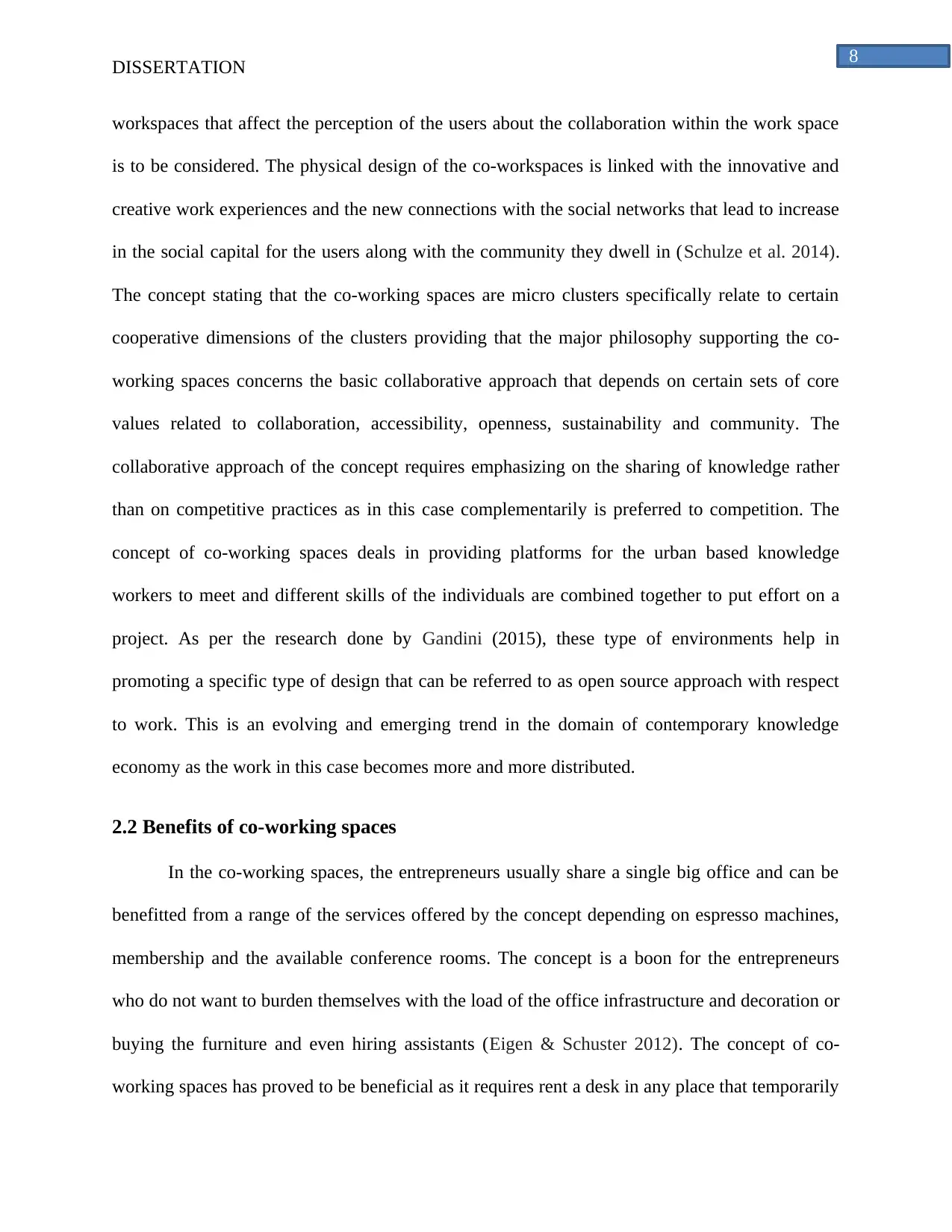
8
DISSERTATION
workspaces that affect the perception of the users about the collaboration within the work space
is to be considered. The physical design of the co-workspaces is linked with the innovative and
creative work experiences and the new connections with the social networks that lead to increase
in the social capital for the users along with the community they dwell in (Schulze et al. 2014).
The concept stating that the co-working spaces are micro clusters specifically relate to certain
cooperative dimensions of the clusters providing that the major philosophy supporting the co-
working spaces concerns the basic collaborative approach that depends on certain sets of core
values related to collaboration, accessibility, openness, sustainability and community. The
collaborative approach of the concept requires emphasizing on the sharing of knowledge rather
than on competitive practices as in this case complementarily is preferred to competition. The
concept of co-working spaces deals in providing platforms for the urban based knowledge
workers to meet and different skills of the individuals are combined together to put effort on a
project. As per the research done by Gandini (2015), these type of environments help in
promoting a specific type of design that can be referred to as open source approach with respect
to work. This is an evolving and emerging trend in the domain of contemporary knowledge
economy as the work in this case becomes more and more distributed.
2.2 Benefits of co-working spaces
In the co-working spaces, the entrepreneurs usually share a single big office and can be
benefitted from a range of the services offered by the concept depending on espresso machines,
membership and the available conference rooms. The concept is a boon for the entrepreneurs
who do not want to burden themselves with the load of the office infrastructure and decoration or
buying the furniture and even hiring assistants (Eigen & Schuster 2012). The concept of co-
working spaces has proved to be beneficial as it requires rent a desk in any place that temporarily
DISSERTATION
workspaces that affect the perception of the users about the collaboration within the work space
is to be considered. The physical design of the co-workspaces is linked with the innovative and
creative work experiences and the new connections with the social networks that lead to increase
in the social capital for the users along with the community they dwell in (Schulze et al. 2014).
The concept stating that the co-working spaces are micro clusters specifically relate to certain
cooperative dimensions of the clusters providing that the major philosophy supporting the co-
working spaces concerns the basic collaborative approach that depends on certain sets of core
values related to collaboration, accessibility, openness, sustainability and community. The
collaborative approach of the concept requires emphasizing on the sharing of knowledge rather
than on competitive practices as in this case complementarily is preferred to competition. The
concept of co-working spaces deals in providing platforms for the urban based knowledge
workers to meet and different skills of the individuals are combined together to put effort on a
project. As per the research done by Gandini (2015), these type of environments help in
promoting a specific type of design that can be referred to as open source approach with respect
to work. This is an evolving and emerging trend in the domain of contemporary knowledge
economy as the work in this case becomes more and more distributed.
2.2 Benefits of co-working spaces
In the co-working spaces, the entrepreneurs usually share a single big office and can be
benefitted from a range of the services offered by the concept depending on espresso machines,
membership and the available conference rooms. The concept is a boon for the entrepreneurs
who do not want to burden themselves with the load of the office infrastructure and decoration or
buying the furniture and even hiring assistants (Eigen & Schuster 2012). The concept of co-
working spaces has proved to be beneficial as it requires rent a desk in any place that temporarily
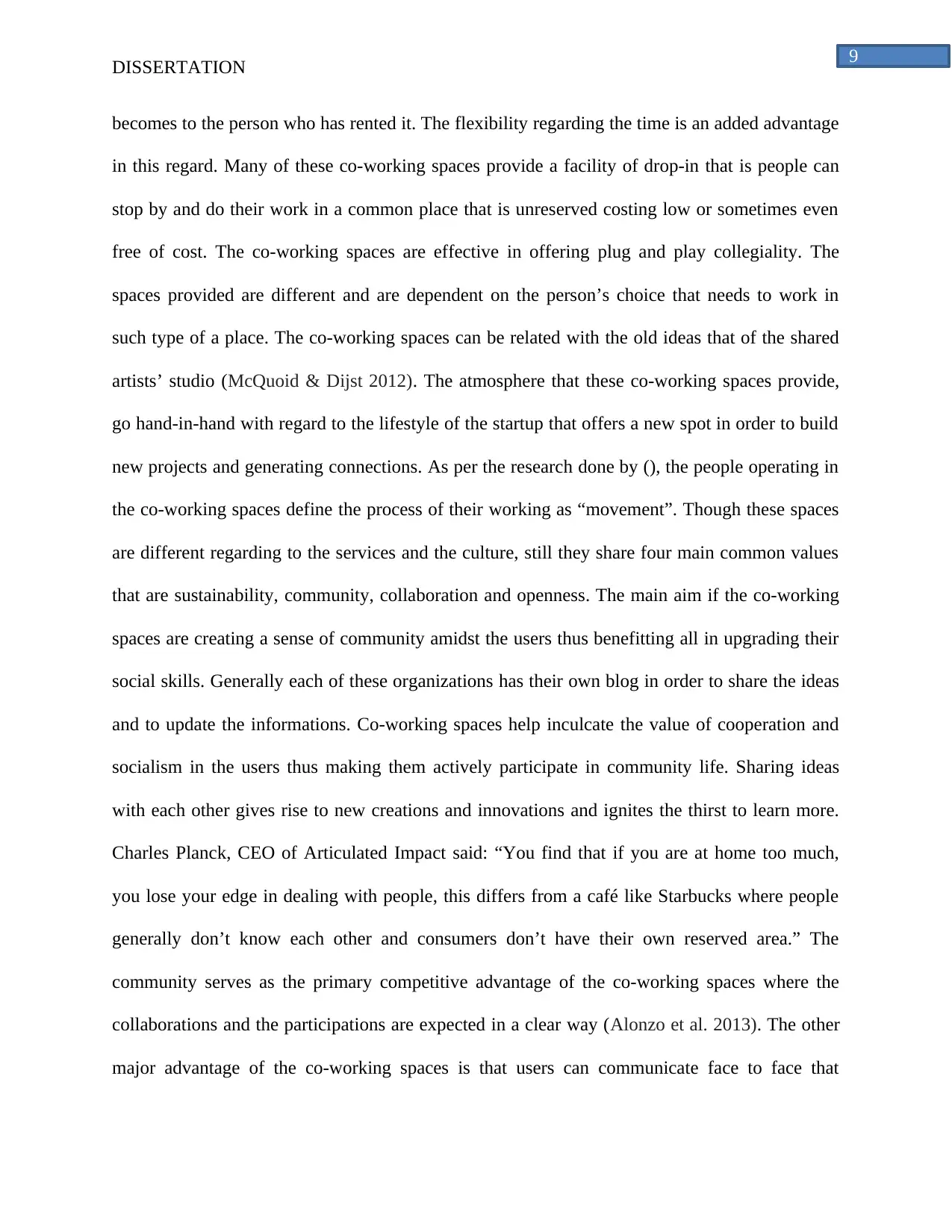
9
DISSERTATION
becomes to the person who has rented it. The flexibility regarding the time is an added advantage
in this regard. Many of these co-working spaces provide a facility of drop-in that is people can
stop by and do their work in a common place that is unreserved costing low or sometimes even
free of cost. The co-working spaces are effective in offering plug and play collegiality. The
spaces provided are different and are dependent on the person’s choice that needs to work in
such type of a place. The co-working spaces can be related with the old ideas that of the shared
artists’ studio (McQuoid & Dijst 2012). The atmosphere that these co-working spaces provide,
go hand-in-hand with regard to the lifestyle of the startup that offers a new spot in order to build
new projects and generating connections. As per the research done by (), the people operating in
the co-working spaces define the process of their working as “movement”. Though these spaces
are different regarding to the services and the culture, still they share four main common values
that are sustainability, community, collaboration and openness. The main aim if the co-working
spaces are creating a sense of community amidst the users thus benefitting all in upgrading their
social skills. Generally each of these organizations has their own blog in order to share the ideas
and to update the informations. Co-working spaces help inculcate the value of cooperation and
socialism in the users thus making them actively participate in community life. Sharing ideas
with each other gives rise to new creations and innovations and ignites the thirst to learn more.
Charles Planck, CEO of Articulated Impact said: “You find that if you are at home too much,
you lose your edge in dealing with people, this differs from a café like Starbucks where people
generally don’t know each other and consumers don’t have their own reserved area.” The
community serves as the primary competitive advantage of the co-working spaces where the
collaborations and the participations are expected in a clear way (Alonzo et al. 2013). The other
major advantage of the co-working spaces is that users can communicate face to face that
DISSERTATION
becomes to the person who has rented it. The flexibility regarding the time is an added advantage
in this regard. Many of these co-working spaces provide a facility of drop-in that is people can
stop by and do their work in a common place that is unreserved costing low or sometimes even
free of cost. The co-working spaces are effective in offering plug and play collegiality. The
spaces provided are different and are dependent on the person’s choice that needs to work in
such type of a place. The co-working spaces can be related with the old ideas that of the shared
artists’ studio (McQuoid & Dijst 2012). The atmosphere that these co-working spaces provide,
go hand-in-hand with regard to the lifestyle of the startup that offers a new spot in order to build
new projects and generating connections. As per the research done by (), the people operating in
the co-working spaces define the process of their working as “movement”. Though these spaces
are different regarding to the services and the culture, still they share four main common values
that are sustainability, community, collaboration and openness. The main aim if the co-working
spaces are creating a sense of community amidst the users thus benefitting all in upgrading their
social skills. Generally each of these organizations has their own blog in order to share the ideas
and to update the informations. Co-working spaces help inculcate the value of cooperation and
socialism in the users thus making them actively participate in community life. Sharing ideas
with each other gives rise to new creations and innovations and ignites the thirst to learn more.
Charles Planck, CEO of Articulated Impact said: “You find that if you are at home too much,
you lose your edge in dealing with people, this differs from a café like Starbucks where people
generally don’t know each other and consumers don’t have their own reserved area.” The
community serves as the primary competitive advantage of the co-working spaces where the
collaborations and the participations are expected in a clear way (Alonzo et al. 2013). The other
major advantage of the co-working spaces is that users can communicate face to face that
⊘ This is a preview!⊘
Do you want full access?
Subscribe today to unlock all pages.

Trusted by 1+ million students worldwide
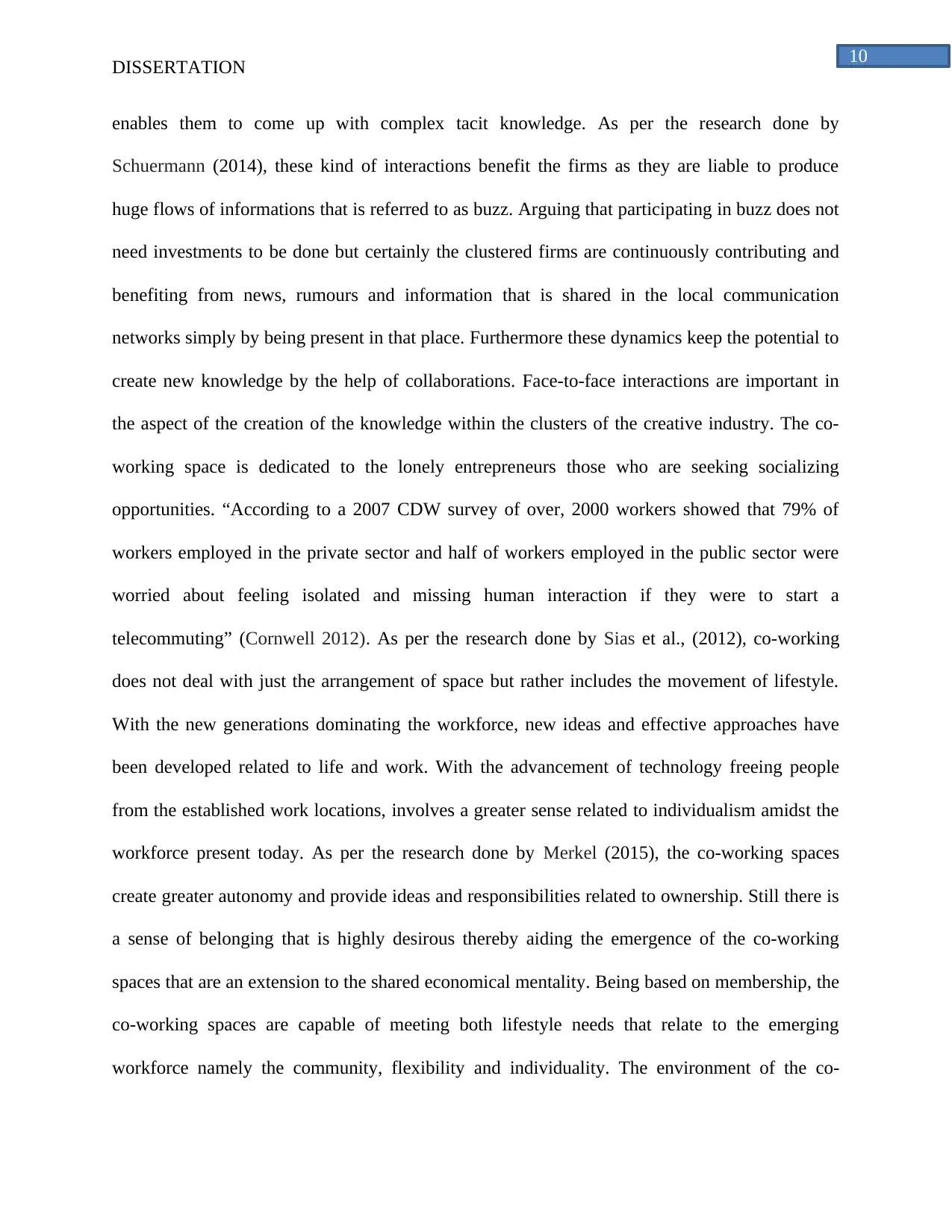
10
DISSERTATION
enables them to come up with complex tacit knowledge. As per the research done by
Schuermann (2014), these kind of interactions benefit the firms as they are liable to produce
huge flows of informations that is referred to as buzz. Arguing that participating in buzz does not
need investments to be done but certainly the clustered firms are continuously contributing and
benefiting from news, rumours and information that is shared in the local communication
networks simply by being present in that place. Furthermore these dynamics keep the potential to
create new knowledge by the help of collaborations. Face-to-face interactions are important in
the aspect of the creation of the knowledge within the clusters of the creative industry. The co-
working space is dedicated to the lonely entrepreneurs those who are seeking socializing
opportunities. “According to a 2007 CDW survey of over, 2000 workers showed that 79% of
workers employed in the private sector and half of workers employed in the public sector were
worried about feeling isolated and missing human interaction if they were to start a
telecommuting” (Cornwell 2012). As per the research done by Sias et al., (2012), co-working
does not deal with just the arrangement of space but rather includes the movement of lifestyle.
With the new generations dominating the workforce, new ideas and effective approaches have
been developed related to life and work. With the advancement of technology freeing people
from the established work locations, involves a greater sense related to individualism amidst the
workforce present today. As per the research done by Merkel (2015), the co-working spaces
create greater autonomy and provide ideas and responsibilities related to ownership. Still there is
a sense of belonging that is highly desirous thereby aiding the emergence of the co-working
spaces that are an extension to the shared economical mentality. Being based on membership, the
co-working spaces are capable of meeting both lifestyle needs that relate to the emerging
workforce namely the community, flexibility and individuality. The environment of the co-
DISSERTATION
enables them to come up with complex tacit knowledge. As per the research done by
Schuermann (2014), these kind of interactions benefit the firms as they are liable to produce
huge flows of informations that is referred to as buzz. Arguing that participating in buzz does not
need investments to be done but certainly the clustered firms are continuously contributing and
benefiting from news, rumours and information that is shared in the local communication
networks simply by being present in that place. Furthermore these dynamics keep the potential to
create new knowledge by the help of collaborations. Face-to-face interactions are important in
the aspect of the creation of the knowledge within the clusters of the creative industry. The co-
working space is dedicated to the lonely entrepreneurs those who are seeking socializing
opportunities. “According to a 2007 CDW survey of over, 2000 workers showed that 79% of
workers employed in the private sector and half of workers employed in the public sector were
worried about feeling isolated and missing human interaction if they were to start a
telecommuting” (Cornwell 2012). As per the research done by Sias et al., (2012), co-working
does not deal with just the arrangement of space but rather includes the movement of lifestyle.
With the new generations dominating the workforce, new ideas and effective approaches have
been developed related to life and work. With the advancement of technology freeing people
from the established work locations, involves a greater sense related to individualism amidst the
workforce present today. As per the research done by Merkel (2015), the co-working spaces
create greater autonomy and provide ideas and responsibilities related to ownership. Still there is
a sense of belonging that is highly desirous thereby aiding the emergence of the co-working
spaces that are an extension to the shared economical mentality. Being based on membership, the
co-working spaces are capable of meeting both lifestyle needs that relate to the emerging
workforce namely the community, flexibility and individuality. The environment of the co-
Paraphrase This Document
Need a fresh take? Get an instant paraphrase of this document with our AI Paraphraser
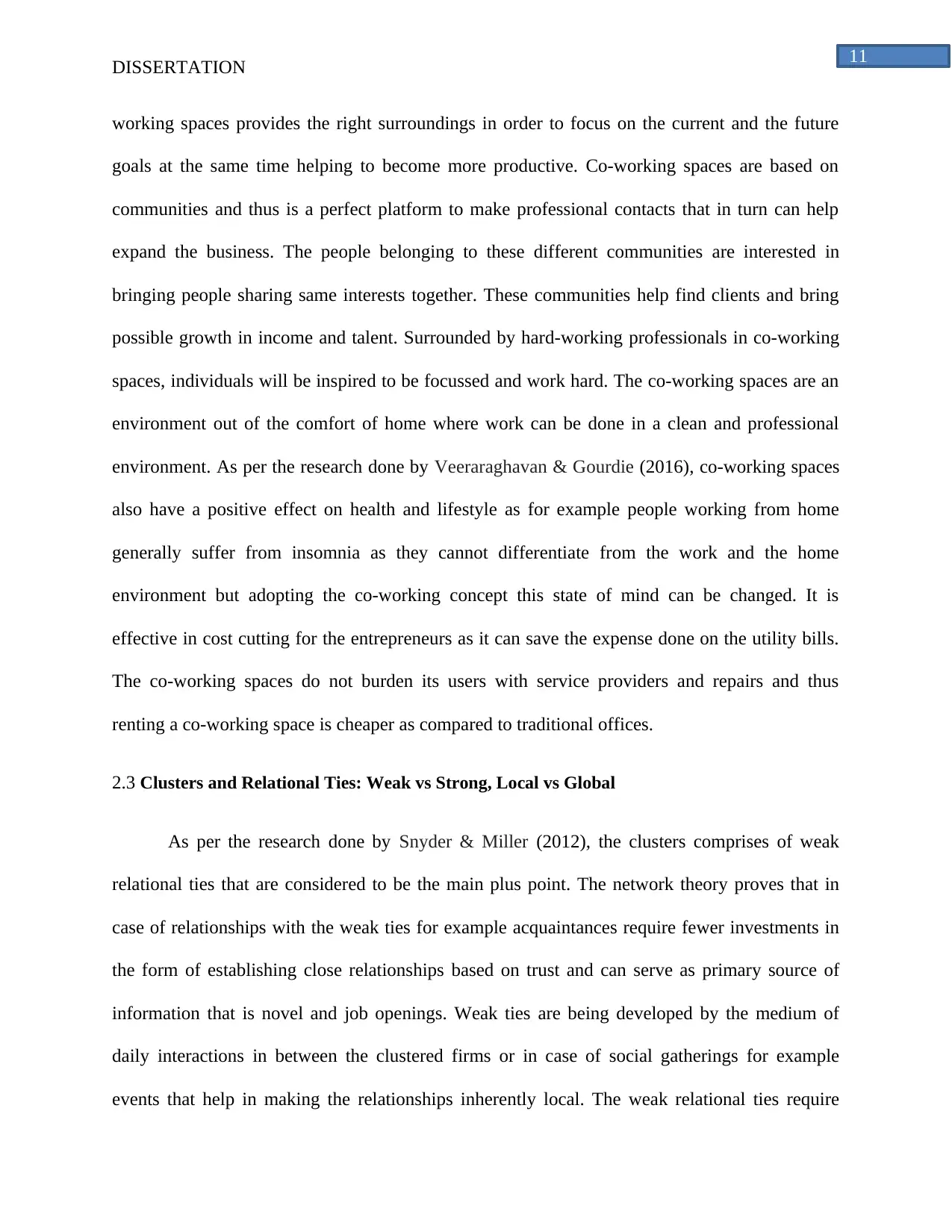
11
DISSERTATION
working spaces provides the right surroundings in order to focus on the current and the future
goals at the same time helping to become more productive. Co-working spaces are based on
communities and thus is a perfect platform to make professional contacts that in turn can help
expand the business. The people belonging to these different communities are interested in
bringing people sharing same interests together. These communities help find clients and bring
possible growth in income and talent. Surrounded by hard-working professionals in co-working
spaces, individuals will be inspired to be focussed and work hard. The co-working spaces are an
environment out of the comfort of home where work can be done in a clean and professional
environment. As per the research done by Veeraraghavan & Gourdie (2016), co-working spaces
also have a positive effect on health and lifestyle as for example people working from home
generally suffer from insomnia as they cannot differentiate from the work and the home
environment but adopting the co-working concept this state of mind can be changed. It is
effective in cost cutting for the entrepreneurs as it can save the expense done on the utility bills.
The co-working spaces do not burden its users with service providers and repairs and thus
renting a co-working space is cheaper as compared to traditional offices.
2.3 Clusters and Relational Ties: Weak vs Strong, Local vs Global
As per the research done by Snyder & Miller (2012), the clusters comprises of weak
relational ties that are considered to be the main plus point. The network theory proves that in
case of relationships with the weak ties for example acquaintances require fewer investments in
the form of establishing close relationships based on trust and can serve as primary source of
information that is novel and job openings. Weak ties are being developed by the medium of
daily interactions in between the clustered firms or in case of social gatherings for example
events that help in making the relationships inherently local. The weak relational ties require
DISSERTATION
working spaces provides the right surroundings in order to focus on the current and the future
goals at the same time helping to become more productive. Co-working spaces are based on
communities and thus is a perfect platform to make professional contacts that in turn can help
expand the business. The people belonging to these different communities are interested in
bringing people sharing same interests together. These communities help find clients and bring
possible growth in income and talent. Surrounded by hard-working professionals in co-working
spaces, individuals will be inspired to be focussed and work hard. The co-working spaces are an
environment out of the comfort of home where work can be done in a clean and professional
environment. As per the research done by Veeraraghavan & Gourdie (2016), co-working spaces
also have a positive effect on health and lifestyle as for example people working from home
generally suffer from insomnia as they cannot differentiate from the work and the home
environment but adopting the co-working concept this state of mind can be changed. It is
effective in cost cutting for the entrepreneurs as it can save the expense done on the utility bills.
The co-working spaces do not burden its users with service providers and repairs and thus
renting a co-working space is cheaper as compared to traditional offices.
2.3 Clusters and Relational Ties: Weak vs Strong, Local vs Global
As per the research done by Snyder & Miller (2012), the clusters comprises of weak
relational ties that are considered to be the main plus point. The network theory proves that in
case of relationships with the weak ties for example acquaintances require fewer investments in
the form of establishing close relationships based on trust and can serve as primary source of
information that is novel and job openings. Weak ties are being developed by the medium of
daily interactions in between the clustered firms or in case of social gatherings for example
events that help in making the relationships inherently local. The weak relational ties require
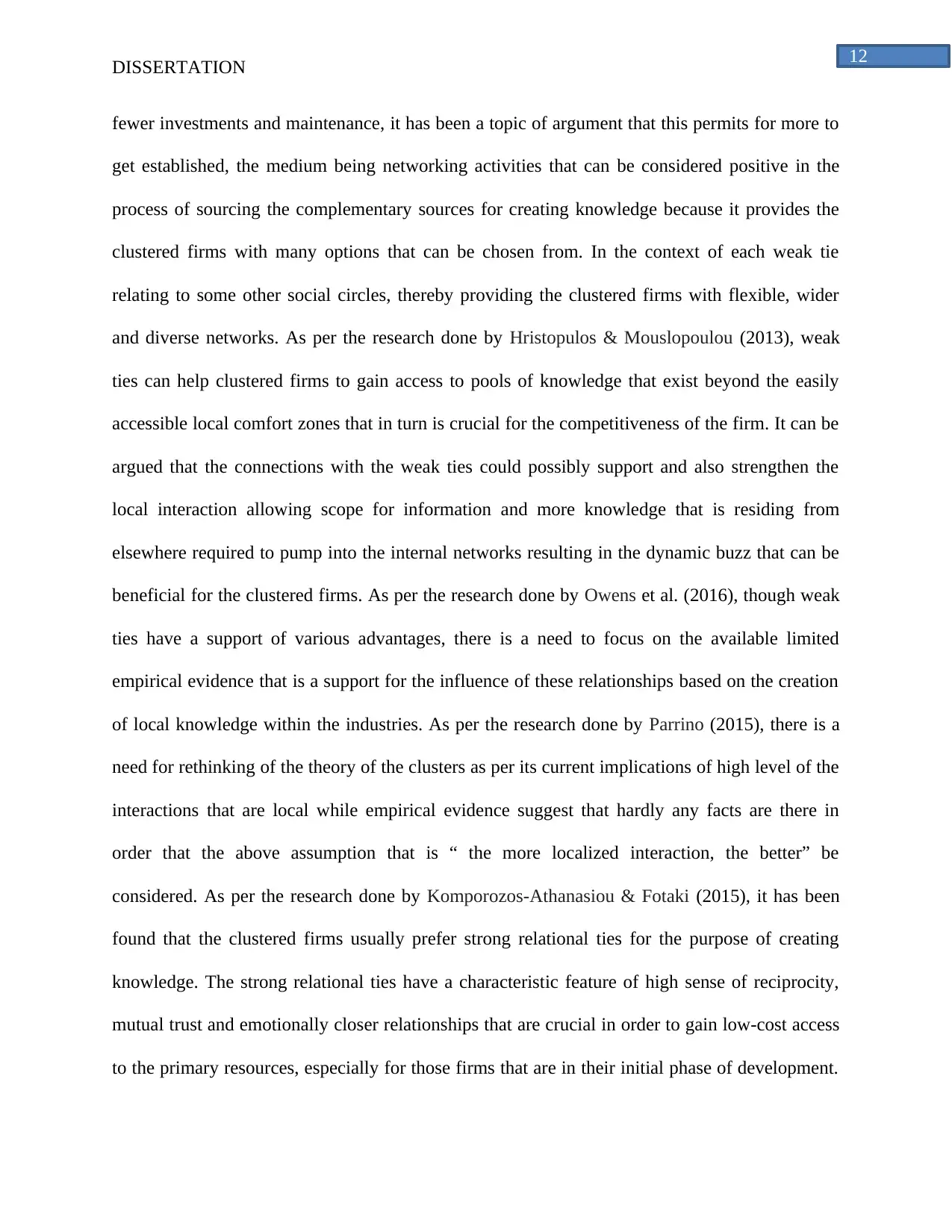
12
DISSERTATION
fewer investments and maintenance, it has been a topic of argument that this permits for more to
get established, the medium being networking activities that can be considered positive in the
process of sourcing the complementary sources for creating knowledge because it provides the
clustered firms with many options that can be chosen from. In the context of each weak tie
relating to some other social circles, thereby providing the clustered firms with flexible, wider
and diverse networks. As per the research done by Hristopulos & Mouslopoulou (2013), weak
ties can help clustered firms to gain access to pools of knowledge that exist beyond the easily
accessible local comfort zones that in turn is crucial for the competitiveness of the firm. It can be
argued that the connections with the weak ties could possibly support and also strengthen the
local interaction allowing scope for information and more knowledge that is residing from
elsewhere required to pump into the internal networks resulting in the dynamic buzz that can be
beneficial for the clustered firms. As per the research done by Owens et al. (2016), though weak
ties have a support of various advantages, there is a need to focus on the available limited
empirical evidence that is a support for the influence of these relationships based on the creation
of local knowledge within the industries. As per the research done by Parrino (2015), there is a
need for rethinking of the theory of the clusters as per its current implications of high level of the
interactions that are local while empirical evidence suggest that hardly any facts are there in
order that the above assumption that is “ the more localized interaction, the better” be
considered. As per the research done by Komporozos-Athanasiou & Fotaki (2015), it has been
found that the clustered firms usually prefer strong relational ties for the purpose of creating
knowledge. The strong relational ties have a characteristic feature of high sense of reciprocity,
mutual trust and emotionally closer relationships that are crucial in order to gain low-cost access
to the primary resources, especially for those firms that are in their initial phase of development.
DISSERTATION
fewer investments and maintenance, it has been a topic of argument that this permits for more to
get established, the medium being networking activities that can be considered positive in the
process of sourcing the complementary sources for creating knowledge because it provides the
clustered firms with many options that can be chosen from. In the context of each weak tie
relating to some other social circles, thereby providing the clustered firms with flexible, wider
and diverse networks. As per the research done by Hristopulos & Mouslopoulou (2013), weak
ties can help clustered firms to gain access to pools of knowledge that exist beyond the easily
accessible local comfort zones that in turn is crucial for the competitiveness of the firm. It can be
argued that the connections with the weak ties could possibly support and also strengthen the
local interaction allowing scope for information and more knowledge that is residing from
elsewhere required to pump into the internal networks resulting in the dynamic buzz that can be
beneficial for the clustered firms. As per the research done by Owens et al. (2016), though weak
ties have a support of various advantages, there is a need to focus on the available limited
empirical evidence that is a support for the influence of these relationships based on the creation
of local knowledge within the industries. As per the research done by Parrino (2015), there is a
need for rethinking of the theory of the clusters as per its current implications of high level of the
interactions that are local while empirical evidence suggest that hardly any facts are there in
order that the above assumption that is “ the more localized interaction, the better” be
considered. As per the research done by Komporozos-Athanasiou & Fotaki (2015), it has been
found that the clustered firms usually prefer strong relational ties for the purpose of creating
knowledge. The strong relational ties have a characteristic feature of high sense of reciprocity,
mutual trust and emotionally closer relationships that are crucial in order to gain low-cost access
to the primary resources, especially for those firms that are in their initial phase of development.
⊘ This is a preview!⊘
Do you want full access?
Subscribe today to unlock all pages.

Trusted by 1+ million students worldwide
1 out of 47
Related Documents
Your All-in-One AI-Powered Toolkit for Academic Success.
+13062052269
info@desklib.com
Available 24*7 on WhatsApp / Email
![[object Object]](/_next/static/media/star-bottom.7253800d.svg)
Unlock your academic potential
Copyright © 2020–2025 A2Z Services. All Rights Reserved. Developed and managed by ZUCOL.





